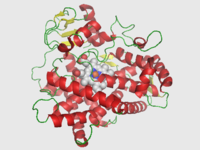
Photo from wikipedia
CYP2B6 is a human microsomal cytochrome P450 enzyme with broad substrate selectivity. CYP2B6 is the only functional member of the human CYP2B gene subfamily, which differs from the situation in… Click to show full abstract
CYP2B6 is a human microsomal cytochrome P450 enzyme with broad substrate selectivity. CYP2B6 is the only functional member of the human CYP2B gene subfamily, which differs from the situation in rodents, such as mouse, where multiple functional Cyp2b genes are expressed. Recent studies with Cyp2b knockout or knockdown mouse models have yielded insights into the in vivo roles of mouse CYP2B enzymes in drug disposition and xenobiotic toxicity. A CYP2B6-humanized mouse model (CYP2A13/2B6/2F1-transgenic/Cyp2abfgs-null), which expresses human CYP2B6 in the liver, and human CYP2A13 and CYP2F1 in the respiratory tract, but not any of the mouse Cyp2b genes, has also been established. In the CYP2B6-humanized mouse, the CYP2B6 transgene is expressed primarily in the liver, where it was found to be active toward prototype CYP2B6 substrate drugs. The regulatory elements of the CYP2B6 transgene appear to be compatible with mouse nuclear receptors that mediate CYP2B induction. Therefore, the CYP2B6-humanized mouse is a valuable animal model for studying the impact of CYP2B6 expression or induction on drug metabolism, drug efficacy, drug-drug interaction, and drug/xenobiotic toxicity. In this mini-review, we provide a brief background on CYP2B6 and the Cyp2b-knockout and CYP2B6-humanized mice, and discuss the potential applications and limitations of the current models.
Journal Title: Drug metabolism and pharmacokinetics
Year Published: 2018
Link to full text (if available)
Share on Social Media: Sign Up to like & get
recommendations!